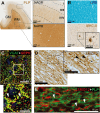A focus on the normal-appearing white and gray matter within the multiple sclerosis brain: a link to smoldering progression
- PMID: 40783892
- PMCID: PMC12336099
- DOI: 10.1007/s00401-025-02923-1
A focus on the normal-appearing white and gray matter within the multiple sclerosis brain: a link to smoldering progression
Abstract
Multiple sclerosis is a chronic neuro-inflammatory and neurodegenerative disease, traditionally characterized by the presence of focal demyelinating lesions in the CNS. However, accumulating evidence suggests that multiple sclerosis pathophysiology extends beyond such classical lesions, affecting also 'normal' appearing tissue in both white and gray matter, referred to as 'normal-appearing white matter' and 'normal-appearing gray matter', respectively. Here, we provide a comprehensive overview of the widespread biochemical, cellular, and microstructural alterations occurring in these 'normal-appearing' CNS regions. Additionally, we discuss the evidence derived from human post-mortem studies that support that normal-appearing white and gray matter could be the drivers of smoldering-associated pathological worsening once repair mechanisms are exhausted. Comprehensive understanding of multiple sclerosis pathology beyond classical lesions not only provides a more complete picture of disease progression, but also provides further insights into potential novel therapeutic avenues in order to slow or halt disability accumulation.
Keywords: Degeneration; Myelin; Oligodendrocyte; Smoldering disease.
© 2025. The Author(s).
Conflict of interest statement
Declarations. Conflict of interest: The authors declare no competing interests.
Figures




Similar articles
-
Uncommon Non-MS Demyelinating Disorders of the Central Nervous System.Curr Neurol Neurosci Rep. 2025 Jul 1;25(1):45. doi: 10.1007/s11910-025-01432-8. Curr Neurol Neurosci Rep. 2025. PMID: 40591029 Review.
-
Targeted magnetic resonance imaging (tMRI) of small changes in the T1 and spatial properties of normal or near normal appearing white and gray matter in disease of the brain using divided subtracted inversion recovery (dSIR) and divided reverse subtracted inversion recovery (drSIR) sequences.Quant Imaging Med Surg. 2023 Oct 1;13(10):7304-7337. doi: 10.21037/qims-23-232. Epub 2023 Aug 15. Quant Imaging Med Surg. 2023. PMID: 37869282 Free PMC article. Review.
-
Mapping motor and extra-motor gray and white matter changes in ALS: a comprehensive review of MRI insights.Neuroradiology. 2025 Jul;67(7):1683-1696. doi: 10.1007/s00234-025-03629-7. Epub 2025 May 2. Neuroradiology. 2025. PMID: 40314791 Free PMC article. Review.
-
Siponimod for multiple sclerosis.Cochrane Database Syst Rev. 2021 Nov 16;11(11):CD013647. doi: 10.1002/14651858.CD013647.pub2. Cochrane Database Syst Rev. 2021. PMID: 34783010 Free PMC article.
-
WITHDRAWN: Interventions for fatigue and weight loss in adults with advanced progressive illness.Cochrane Database Syst Rev. 2017 Apr 7;4(4):CD008427. doi: 10.1002/14651858.CD008427.pub3. Cochrane Database Syst Rev. 2017. PMID: 28387447 Free PMC article.
References
Publication types
MeSH terms
Grants and funding
LinkOut - more resources
Full Text Sources
Medical

